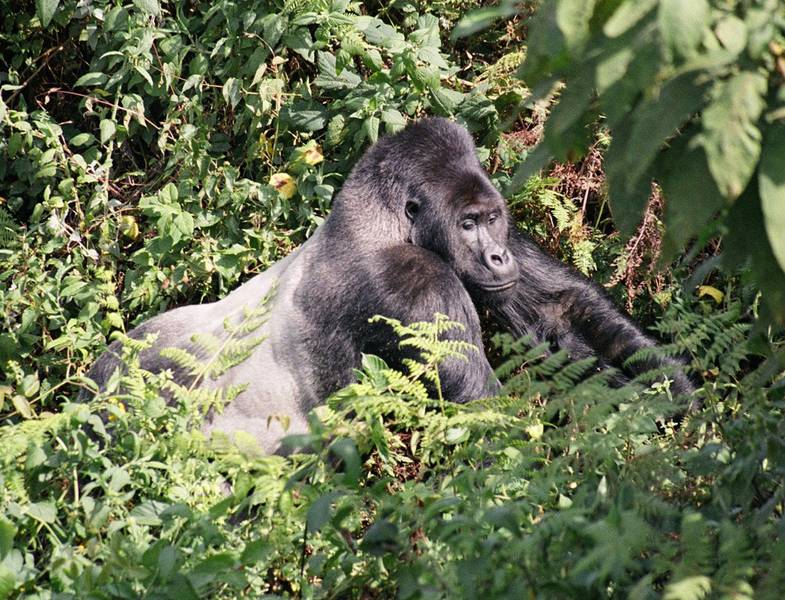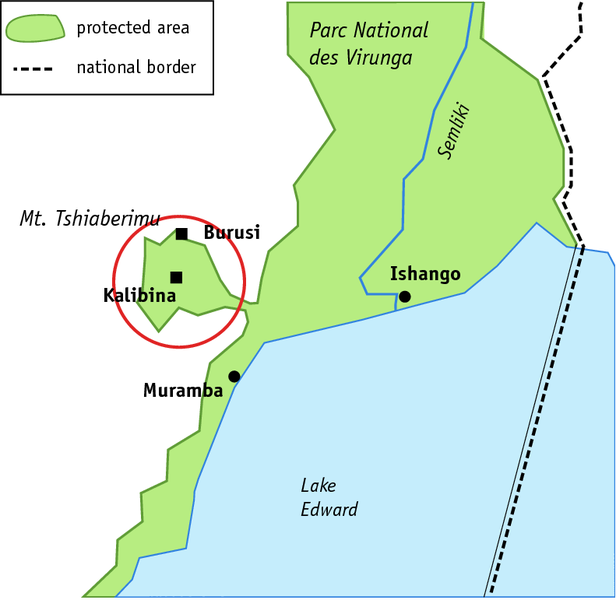Mt. Tshiaberimu Project 2008
Categories: Gorilla Journal, Journal no. 38, Threats, Democratic Republic of the Congo, Mt. Tshiaberimu, Grauer's Gorilla
2008 has been a very difficult year for The Gorilla Organization on Mt Tshiaberimu. In February 2008 the adult female Mughole of the Kipura group died from a bacterial infection. In May another adult female, Molo, of the same group was also found dead, probably of the same cause.
In August 2008, Musanganya, a juvenile of the Lusenge group fractured its skull falling from a tree. Specialists have taken samples and we are hoping that the ensuing investigation will quickly shed light on the causes of these deaths.
Meanwhile, the growing insecurity in the east of the Democratic Republic of the Congo has had its repercussions on the work at Mt Tshiaberimu. There have been cases of resurgence of armed groups in the region. The insurgent militia are often used by certain politicians against the establishment of the park and therefore seek out park rangers as their targets. During one clash between park rangers and the militia in January 2009 the head of monitoring Kakule Safari was killed. Recently another ranger, Katambireki of the Karumrume sector not far from Mt Tshiaberimu, lost his life in another incident.
Regrettably this was not the last of the unfortunate events. Early in 2009, a case of cannibalism was reported from Mt Tshiaberimu, where the female Mwengesyali was found devouring her new-born infant. Finally, in March, the eldest gorilla of the Lusenge group of Mt Tshiaberimu, the silverback Nzanzu, died of old age.
This is the first time that so many deaths have occurred in such a short period of time since the beginning of the project in 1996. Consequently, they have caused great anxiety and frustration within the monitoring team. In spite of these difficulties caused by the insecurity, the deaths of the gorillas and even the global financial crisis, The Gorilla Organization was still able to carry out park protection activities.
Monitoring of the Gorillas
During monitoring, special attention was given to the diet of the gorillas and the way they exploit their territory. In addition to the known 84 plant species eaten by the gorillas, 3 new species were identified, bringing the total number of known food sources for the gorillas of Mt Tshiaberimu to 87. 95% of the bamboo forest area was exploited by the gorillas in the course of 2008 up to December, and 10 interactions between the different groups were observed.
Observations and Inventory of the Fauna
Thanks to the efforts of The Gorilla Organization, the biodiversity of Mt Tshiaberimu is also being surveyed. During 2008 we observed a noticeable increase in the number of Cercopithecus mitis (about 361 compared to 100-160 individuals observed previously): this might cause competition between the gorillas and the Cercopithecus, especially for young bamboo sprouts.
An inventory of the birds of Mt Tshiaberimu has been carried out, identifying 145 species, with 7 species endemic to the Albertine Rift, including the well-known Cryptospiza shelleyi (Shelley's crimsonwing).
Monitoring Patrols
In an anti-poaching effort, 168 patrols were conducted and two semi-permanent tented camps have been set up. The patrols have been able to destroy 51 traps, put a stop to timber felling and pit-sawing (75 boards have been found and confiscated), end the encroachment on the park in the Kabeka sector, and prevent bush fires that have recently destroyed 2 ha south of the patrol post of Mulango wa Nyama.
Education Campaigns and Awareness-raising
During 2008, campaigns to educate and raise awareness of the conservation of the environment in general, and the habitat of the gorillas in particular, have included the showing of films (in cooperation with the Great Apes Film Initiative), conferences, seminars, meetings with the chiefs from villages bordering the gorillas' habitat, distribution of the newsletter Digit News, calendars and posters about the health of humans and animals and on birds.
Meetings and debates held in 53 schools and universities have allowed us to raise awareness amongst 16,467 pupils, students and teaching staff concerning the threats to the great apes and their habitats. Contacts have been made with village chiefs bordering the gorillas' territories. The NGO SAGoT (Solidarité des Amis des Gorilles de Tshiaberimu) comprising 10 CBOs (community-based organisations with more than 1,600 members) benefitted from training courses in business to reduce poverty in the regions around the gorilla habitat.
53 radio programmes were broadcast in collaboration with local chiefs, leaders of the CBOs and religious and university authorities, covering topics related to current environmental problems and the threats that endanger the survival of the great apes.
Community Development
The Gorilla Organization has given support to a local school and a health centre through the programme for community development around the gorilla habitat. In fact, the precarious situation of community health and the low educational level of the population living around the park also pose a danger to the survival of the gorillas.
In addition, SAGoT member associations have received substantial support in agricultural materials (vegetable seeds and agricultural tools) through generous aid from FAO to The Gorilla Organization. Food security and improved income generation around the protected areas are another way of ensuring the long-term protection of endangered species.
The Gorilla Organization has also sponsored the maintenance of a total of 38 km of agricultural access roads around Mt Tshiaberimu by paying monthly subsidies for 28 road workers and their equipment.
Direct support from Berggorilla & Regenwald Direkthilfe has allowed SAGoT to benefit from a tree nursery project with a capacity for producing 40,000 seedlings to reforest the area around Mt Tshiaberimu.
Finally, The Gorilla Organization has been able to pay subsidies and salaries for 91 staff (of ICCN and The Gorilla Organization), which has enabled the employees to feed their families (500 people altogether) during the whole of 2008 and to pay for schooling and medical expenses - all thanks to the gorillas.
In view of all the visible advantages of conservation, the recent gorilla deaths and the political attacks on park staff are causing concern among the human population bordering Mt Tshiaberimu, and they fear for the future of this small gorilla population.
Jean-Claude Kyungu Kasolene, Henry Cirhuza and Jean De Dieu Vhosi
The Mount Tshiaberimu Conservation Project would like to thank the authorities of the ICCN both at the national and the provincial level, especially the ADG, ADT, and the Commissioner for Cooperation, for their efforts to stabilise ICCN in Congo. The team of the Virunga National Park, in particular the Director M. de Merode and his deputy Mushenzi, are recognized for their unfailing support of the Tshiaberimu staff during these difficult times.
We would also like to express our gratitude to the EU through the GRASP/UNEP project for their continued financial support over the past 3 years.


